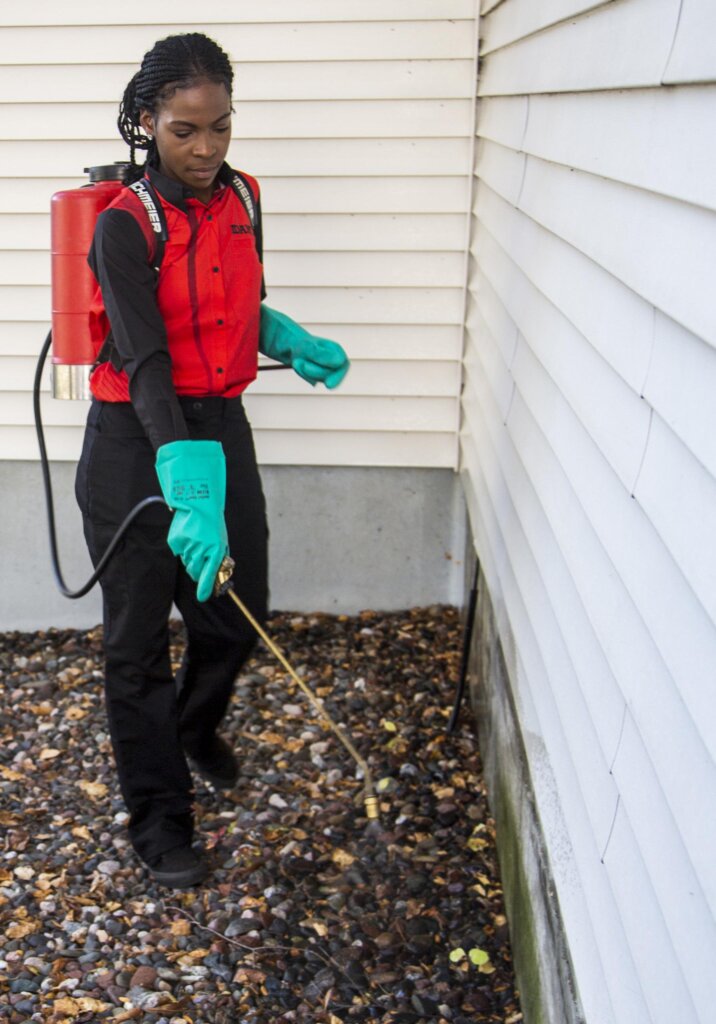Bed Bug Treatment Break Down: Comparing Chemical Vs. Non-Chemical Solutions
In the realm of parasite control, especially when taking care of the consistent concern of bed insects, the option in between chemical and non-chemical therapy services can be an essential one. Both approaches use distinct advantages and drawbacks, influencing elements such as effectiveness, safety factors to consider, and general expense. By analyzing the nuanced information of each technique, a clearer understanding of which course to pursue in attending to a bed pest infestation can be attained.
Efficiency of Chemical Therapies
Chemical therapies for bed pest infestations have been widely acknowledged for their quick and potent efficacy in eradicating these pests. When thinking about the efficiency of chemical treatments, it is vital to recognize that they can provide a quick and comprehensive option to a bed pest issue. Expert pest control specialists typically rely upon insecticides to target bed pests at different phases of their life process, consisting of nymphs, eggs, and adults. These chemicals generally work by interrupting the bed bugs' nerves, causing paralysis and ultimate death.
Moreover, chemical treatments have the advantage of providing residual results, meaning that they can remain to eliminate bed pests also after the first application. This recurring activity is particularly beneficial in combating any type of potential re-infestations. Additionally, the quick action of chemical treatments can bring alleviation to people encountering extreme bed bug invasions, allowing them to restore control of their home rapidly.
Safety Worry About Chemical Solutions
One critical facet that calls for mindful factor to consider when using chemical remedies for bed pest therapy is guaranteeing the safety of occupants and the atmosphere. Direct exposure to specific chemicals made use of in bed bug therapies can lead to breathing issues, skin inflammation, or various other damaging reactions, specifically in people with pre-existing conditions or sensitivities.
In addition, the ecological influence of chemical options is one more substantial consideration. Some pesticides used in bed bug treatments may be dangerous to useful pests, wildlife, and environments if they seep right into the dirt or water supply. It is necessary to use chemical treatments sensibly, following safety guidelines, and considering less harmful alternatives to mitigate these risks and ensure the reliable and risk-free administration of bed pest problems.
Benefits of Non-Chemical Techniques
Thinking about the possible safety and security issues and ecological impact related to chemical solutions for bed insect treatment, discovering non-chemical techniques presents an appealing choice with several unique benefits. Non-chemical approaches provide a safer choice for households, particularly those with individuals, pets, or children sensitive to extreme chemicals. These approaches get rid of the risks of direct exposure to harmful compounds, reducing the possibility for unfavorable wellness impacts. Moreover, non-chemical therapies are environmentally pleasant, as they do not add to air or water contamination, making them a lasting choice for insect control.
Furthermore, non-chemical solutions can be bug control companies reliable in targeting bed bugs, including hard-to-reach locations where chemical therapies might not penetrate - A1 bed bug exterminator charlotte. Techniques such as heat treatment, vacuuming, vapor cleansing, and bed mattress encasements supply comprehensive removal without the usage of unsafe chemicals.
Limitations of Non-Chemical Treatments

Furthermore, non-chemical treatments frequently call for multiple applications to achieve successful eradication. This can be time-consuming and may not constantly guarantee complete removal of all bed pests and their eggs, particularly in hidden or hard-to-reach locations.
Furthermore, the success of non-chemical treatments greatly depends on appropriate execution and home insect control thoroughness, which can be testing for individuals without expert expertise. Insufficient application of non-chemical approaches may cause incomplete eradication, causing consistent problems and the requirement for added therapies.
Consequently, while non-chemical therapies have their benefits, it is necessary to recognize these limitations and consider them when identifying the most efficient strategy for taking care of bed insect infestations.
Expense Comparison: Chemical Vs. Non-Chemical Options
Offered the limitations associated with non-chemical therapies, a crucial element to review in the context of bed insect monitoring is the cost comparison in between chemical and non-chemical alternatives. In contrast, non-chemical treatments like warm treatment or steam can be a lot why not try these out more expensive, with prices varying from $1,000 to $6,000 for a whole home. While the initial expense of chemical therapies may seem lower, several therapies might be called for to totally eliminate the problem, possibly raising the total price.
Verdict

Considering the potential safety worries and environmental effect connected with chemical remedies for bed insect treatment, exploring non-chemical approaches provides a promising option with numerous unique benefits.Offered the restrictions linked with non-chemical treatments, a necessary facet to examine in the context of bed insect monitoring is the expense contrast in between chemical and non-chemical choices. In comparison, non-chemical treatments like warm treatment or vapor can be a lot more costly, with prices ranging from $1,000 to $6,000 for an entire home. While the preliminary cost of chemical therapies might seem reduced, multiple therapies might be called for to completely eradicate the problem, potentially raising the total cost.In verdict, when contrasting chemical and non-chemical bed bug treatment alternatives, it is crucial to consider performance, safety and security, advantages, constraints, and expense.
Comments on “A1 Bed Bug Exterminator Charlotte - Specialized Bed Bug Removal”